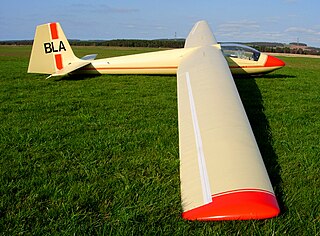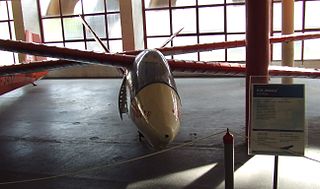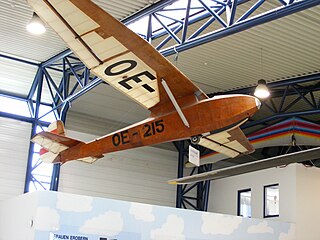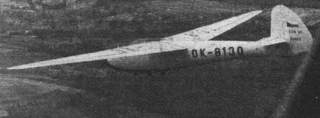
The Slingsby Type 42 Eagle was a two-seat glider designed in England from 1952.

The Slingsby T.8 Kirby Tutor was a single-seat sport glider produced from 1937, by Fred Slingsby in Kirbymoorside, Yorkshire.
The Slingsby T.25 Gull 4 is a British glider designed and built by Slingsby that first flew in 1947.

The Slingsby Type 34 Sky is a high performance single seat competition sailplane built in the United Kingdom. It was successful in major events, particularly in the World Gliding Championships of 1952.

The Slingsby T.30 Prefect is a 1948 British modernisation of the 1932 single-seat Grunau Baby glider. About 53 were built for civil and military training purposes.

The Slingsby Type 45 Swallow was designed as a club sailplane of reasonable performance and price. One of the most successful of Slingsby's gliders in sales terms, over 100 had been built when production was ended by a 1968 factory fire.

The Slingsby T.50 Skylark 4 was a British single seat competition glider built by Slingsby Sailplanes in the early 1960s. It sold in numbers and had success at national, though not world level competition.

The DFS Weihe is a German single-seat, high-wing, 18 metre wingspan, high-performance glider that was designed by Hans Jacobs in 1937-38.
The Czerwiński Sparrow, sometimes known as the de Havilland Canada glider, was a single seat glider, designed and built by a group of de Haviiland engineers in Canada in 1942. It was intended to popularise gliding and be suitable for both basic training and thermal soaring.
The Czerwiński-Shenstone Harbinger, aka the Shenstone-Czerwiński Harbinger or the Shenstone Harbinger was a Canadian high performance tandem seat sailplane designed in Canada. Only two were built, one in the UK and one in Canada. The latter did not fly until 1975, being under construction for 26 years; the former remained active until at least 1994.

The Cijan-Obad Orao is a competition single seat sailplane designed in Yugoslavia just after World War II, one of the most advanced of its type at the time. It flew in three World Gliding Championships, having greatest success at its first in 1950 when it reached third place.

The Ikarus Meteor is a long-span, all-metal sailplane designed and built in Yugoslavia in the 1950s. It competed in World Gliding Championships (WGC) between 1956 and 1968 and was placed fourth in 1956; it also set new triangular-course world speed records.

The Rubik R-25 Mokány, in English: Plucky person and sometimes known as the R-25 Standard (class), is a Hungarian single seat Standard Class glider of all-metal construction, first flown in 1960. It was one of a series of similar aircraft designed by Ernő Rubik. Only one was built.
The Kometa-Standard was a Standard Class glider, designed and built in Bulgaria in the early 1960s. Thirty were flown by local gliding clubs.

The Caudron C.800, at first also known as the Epervier is a French two seat training glider, designed and first flown during World War II and put into large scale post-war production. It was the dominant basic training glider with French clubs until the 1960s and several still fly.

The Arsenal Émouchet, more commonly known as Sports Aériens Émouchet, Air Émouchet, or Guerchais-Roche Émouchet, is a modest performance, single-seat training glider designed and first produced in France during World War II. Quantity production continued post-war, when it played an important part in re-equipping the French glider movement through its clubs.
The Ciani EC.37/53 Spillo or SSVV EC.37/53 Spillo was a single seat competition glider designed and built in Italy in the 1950s. It had the highest aspect ratio wing of any wooden glider. Only one was built.

The Orlican VT-16 Orlik is a single-seat club glider, serving Czech gliding clubs and setting several national records in the early 1960s.
The IIL IS-8 was a two-seat sailplane designed by Iosif Șilimon and built in Romania in 1960. They served with Romanian gliding clubs.

The Zlín Šohaj series of club gliders began as a post World War II development of the DFS Olympia Meise. A large number were built in the 1940s and '50s.














